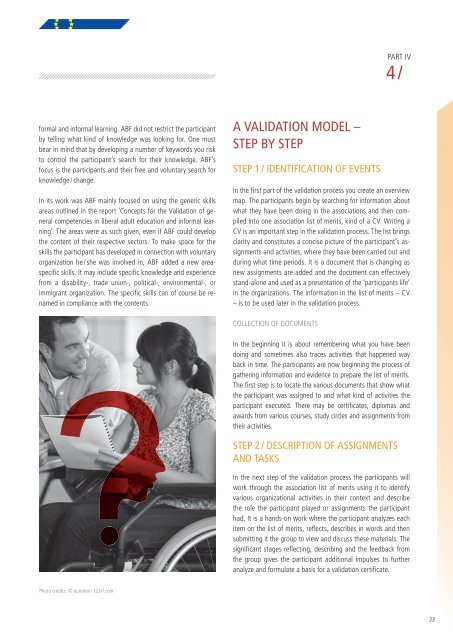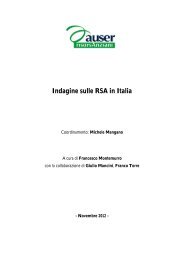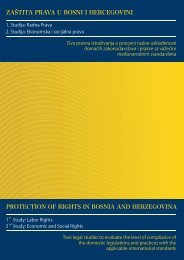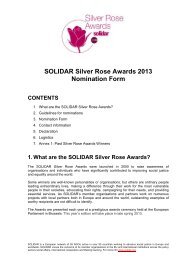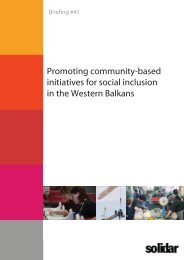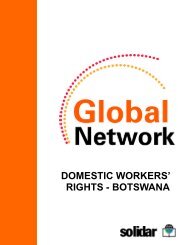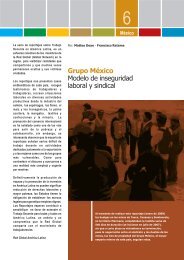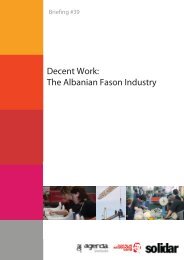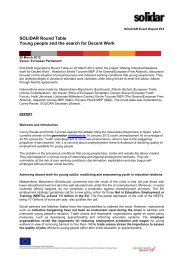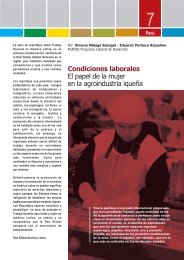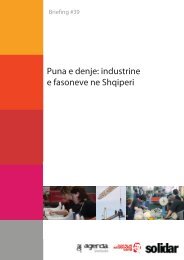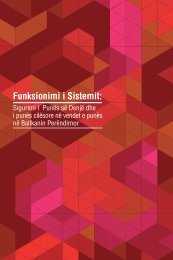RECOGNITION OF NON-FORMAL AND INFORMAL ... - Solidar
RECOGNITION OF NON-FORMAL AND INFORMAL ... - Solidar
RECOGNITION OF NON-FORMAL AND INFORMAL ... - Solidar
You also want an ePaper? Increase the reach of your titles
YUMPU automatically turns print PDFs into web optimized ePapers that Google loves.
PART IV<br />
4 /<br />
formal and informal learning. ABF did not restrict the participant<br />
by telling what kind of knowledge was looking for. One must<br />
bear in mind that by developing a number of keywords you risk<br />
to control the participant’s search for their knowledge. ABF’s<br />
focus is the participants and their free and voluntary search for<br />
knowledge / change.<br />
In its work was ABF mainly focused on using the generic skills<br />
areas outlined in the report ‘Concepts for the Validation of general<br />
competencies in liberal adult education and informal learning’.<br />
The areas were as such given, even if ABF could develop<br />
the content of their respective sectors. To make space for the<br />
skills the participant has developed in connection with voluntary<br />
organization he / she was involved in, ABF added a new areaspecifi<br />
c skills. It may include specifi c knowledge and experience<br />
from a disability-, trade union-, political-, environmental-, or<br />
immigrant organization. The specifi c skills can of course be renamed<br />
in compliance with the contents.<br />
A VALIDATION MODEL –<br />
STEP BY STEP<br />
STEP 1 / IDENTIFICATION <strong>OF</strong> EVENTS<br />
In the fi rst part of the validation process you create an overview<br />
map. The participants begin by searching for information about<br />
what they have been doing in the associations and then compiled<br />
into one association list of merits, kind of a CV. Writing a<br />
CV is an important step in the validation process. The list brings<br />
clarity and constitutes a concise picture of the participant’s assignments<br />
and activities, where they have been carried out and<br />
during what time periods. It is a document that is changing as<br />
new assignments are added and the document can effectively<br />
stand-alone and used as a presentation of the ‘participants life’<br />
in the organizations. The information in the list of merits – CV<br />
– is to be used later in the validation process.<br />
COLLECTION <strong>OF</strong> DOCUMENTS<br />
In the beginning it is about remembering what you have been<br />
doing and sometimes also traces activities that happened way<br />
back in time. The participants are now beginning the process of<br />
gathering information and evidence to prepare the list of merits.<br />
The fi rst step is to locate the various documents that show what<br />
the participant was assigned to and what kind of activities the<br />
participant executed. There may be certifi cates, diplomas and<br />
awards from various courses, study circles and assignments from<br />
their activities.<br />
STEP 2 / DESCRIPTION <strong>OF</strong> ASSIGNMENTS<br />
<strong>AND</strong> TASKS<br />
In the next step of the validation process the participants will<br />
work through the association list of merits using it to identify<br />
various organizational activities in their context and describe<br />
the role the participant played or assignments the participant<br />
had. It is a hands-on work where the participant analyzes each<br />
item on the list of merits, refl ects, describes in words and then<br />
submitting it the group to view and discuss these materials. The<br />
signifi cant stages refl ecting, describing and the feedback from<br />
the group gives the participant additional impulses to further<br />
analyze and formulate a basis for a validation certifi cate.<br />
Photo credits: © auremar / 123rf.com<br />
33


